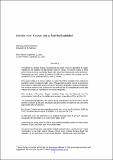Files in this item
Into the mire : A closer look at fossil-fuel subsidies
Item metadata
| dc.contributor.author | Stefanski, Radoslaw (Radek) | |
| dc.date.accessioned | 2016-11-17T12:30:13Z | |
| dc.date.available | 2016-11-17T12:30:13Z | |
| dc.date.issued | 2016-03 | |
| dc.identifier | 241309461 | |
| dc.identifier | 6d75642f-a024-47dd-b0ba-9114e95d7cb9 | |
| dc.identifier.citation | Stefanski , R 2016 , ' Into the mire : A closer look at fossil-fuel subsidies ' , Calgary School of Public Policy Research Papers , vol. 9 , no. 10 . < http://www.policyschool.ca/wp-content/uploads/2016/05/fossil-fuels-stefanski.pdf > | en |
| dc.identifier.uri | https://hdl.handle.net/10023/9833 | |
| dc.description.abstract | Threatened by climate change, governments the world over are attempting to nudge markets in the direction of less carbon-intensive energy. Perversely, many of these governments continue to subsidize fossil fuels, distorting markets and raising emissions. Determing how much money is involved is difficult, as neither the providers nor the recipients of those subsidies want to own up to them. This paper builds on a unique method to extract fossil fuel subsidies from patterns in countries’ carbon emission-to-GDP ratios. This approach is useful since it: 1) overcomes the problem of scarce data; 2) derives a wider and more comparable measure of subsidies than existing measures and 3) allows for the performance of counterfactuals which help measure the impact of subsidies on emissions and growth. The resultant 170-country, 30-year database finds that the financial and the environmental costs of such subsidies are enormous, especially in China and the US. The overwhelming majority of the world’s fossil fuel subsidies stem from China, the US and the ex-USSR; as of 2010, this figure was $712 billion or nearly 80 per cent of the total world value of subsidies. For its part, Canada has been subsidizing rather than taxing fossil fuels since 1998. By 2010, Canadian subsidies sat at $13 billion, or 1.4 per cent of GDP. In that same year, the total direct and indirect financial costs of all such subsidies amounted to $1.82 trillion, or 3.8 per cent of global GDP. Aside from the money saved, in 2010 a world without subsidies would have had carbon emissons 36 per cent lower than they actually were. Any government looking to ease strained budgets and and make a significant (and cheap) contribution to the fight against climate change must consider slashing fossil fuel subsidies. As the data show, this is a sound decision – fiscally and environmentally. | |
| dc.format.extent | 45 | |
| dc.format.extent | 1547073 | |
| dc.language.iso | eng | |
| dc.relation.ispartof | Calgary School of Public Policy Research Papers | en |
| dc.subject | SDG 12 - Responsible Consumption and Production | en |
| dc.subject | SDG 13 - Climate Action | en |
| dc.title | Into the mire : A closer look at fossil-fuel subsidies | en |
| dc.type | Journal article | en |
| dc.contributor.institution | University of St Andrews. School of Economics and Finance | en |
| dc.description.status | Peer reviewed | en |
| dc.identifier.url | http://www.policyschool.ca/authors/stefanski-radoslaw/ | en |
| dc.identifier.url | http://www.policyschool.ca/wp-content/uploads/2016/05/fossil-fuels-stefanski.pdf | en |
This item appears in the following Collection(s)
Items in the St Andrews Research Repository are protected by copyright, with all rights reserved, unless otherwise indicated.

